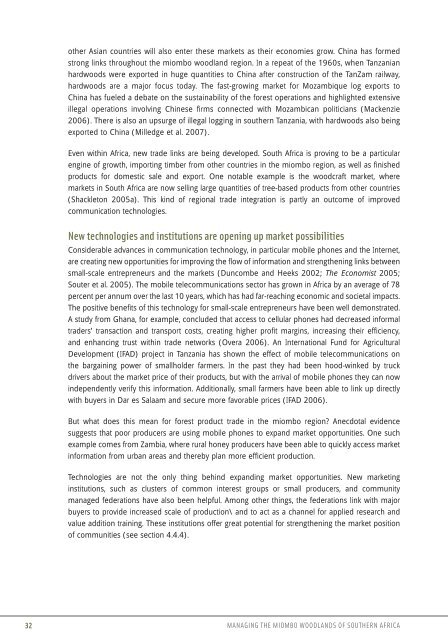Managing the Miombo Woodlands of Southern Africa - PROFOR
Managing the Miombo Woodlands of Southern Africa - PROFOR
Managing the Miombo Woodlands of Southern Africa - PROFOR
You also want an ePaper? Increase the reach of your titles
YUMPU automatically turns print PDFs into web optimized ePapers that Google loves.
o<strong>the</strong>r Asian countries will also enter <strong>the</strong>se markets as <strong>the</strong>ir economies grow. China has formed<br />
strong links throughout <strong>the</strong> miombo woodland region. In a repeat <strong>of</strong> <strong>the</strong> 1960s, when Tanzanian<br />
hardwoods were exported in huge quantities to China after construction <strong>of</strong> <strong>the</strong> TanZam railway,<br />
hardwoods are a major focus today. The fast-growing market for Mozambique log exports to<br />
China has fueled a debate on <strong>the</strong> sustainability <strong>of</strong> <strong>the</strong> forest operations and highlighted extensive<br />
illegal operations involving Chinese fi rms connected with Mozambican politicians (Mackenzie<br />
2006). There is also an upsurge <strong>of</strong> illegal logging in sou<strong>the</strong>rn Tanzania, with hardwoods also being<br />
exported to China (Milledge et al. 2007).<br />
Even within <strong>Africa</strong>, new trade links are being developed. South <strong>Africa</strong> is proving to be a particular<br />
engine <strong>of</strong> growth, importing timber from o<strong>the</strong>r countries in <strong>the</strong> miombo region, as well as fi nished<br />
products for domestic sale and export. One notable example is <strong>the</strong> woodcraft market, where<br />
markets in South <strong>Africa</strong> are now selling large quantities <strong>of</strong> tree-based products from o<strong>the</strong>r countries<br />
(Shackleton 2005a). This kind <strong>of</strong> regional trade integration is partly an outcome <strong>of</strong> improved<br />
communication technologies.<br />
New technologies and institutions are opening up market possibilities<br />
Considerable advances in communication technology, in particular mobile phones and <strong>the</strong> Internet,<br />
are creating new opportunities for improving <strong>the</strong> fl ow <strong>of</strong> information and streng<strong>the</strong>ning links between<br />
small-scale entrepreneurs and <strong>the</strong> markets (Duncombe and Heeks 2002; The Economist 2005;<br />
Souter et al. 2005). The mobile telecommunications sector has grown in <strong>Africa</strong> by an average <strong>of</strong> 78<br />
percent per annum over <strong>the</strong> last 10 years, which has had far-reaching economic and societal impacts.<br />
The positive benefi ts <strong>of</strong> this technology for small-scale entrepreneurs have been well demonstrated.<br />
A study from Ghana, for example, concluded that access to cellular phones had decreased informal<br />
traders’ transaction and transport costs, creating higher pr<strong>of</strong>i t margins, increasing <strong>the</strong>ir effi ciency,<br />
and enhancing trust within trade networks (Overa 2006). An International Fund for Agricultural<br />
Development (IFAD) project in Tanzania has shown <strong>the</strong> effect <strong>of</strong> mobile telecommunications on<br />
<strong>the</strong> bargaining power <strong>of</strong> smallholder farmers. In <strong>the</strong> past <strong>the</strong>y had been hood-winked by truck<br />
drivers about <strong>the</strong> market price <strong>of</strong> <strong>the</strong>ir products, but with <strong>the</strong> arrival <strong>of</strong> mobile phones <strong>the</strong>y can now<br />
independently verify this information. Additionally, small farmers have been able to link up directly<br />
with buyers in Dar es Salaam and secure more favorable prices (IFAD 2006).<br />
But what does this mean for forest product trade in <strong>the</strong> miombo region Anecdotal evidence<br />
suggests that poor producers are using mobile phones to expand market opportunities. One such<br />
example comes from Zambia, where rural honey producers have been able to quickly access market<br />
information from urban areas and <strong>the</strong>reby plan more effi cient production.<br />
Technologies are not <strong>the</strong> only thing behind expanding market opportunities. New marketing<br />
institutions, such as clusters <strong>of</strong> common interest groups or small producers, and community<br />
managed federations have also been helpful. Among o<strong>the</strong>r things, <strong>the</strong> federations link with major<br />
buyers to provide increased scale <strong>of</strong> production\ and to act as a channel for applied research and<br />
value addition training. These institutions <strong>of</strong>fer great potential for streng<strong>the</strong>ning <strong>the</strong> market position<br />
<strong>of</strong> communities (see section 4.4.4).<br />
32 MANAGING THE MIOMBO WOODLANDS OF SOUTHERN AFRICA

















